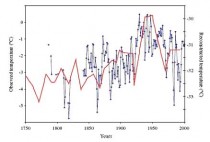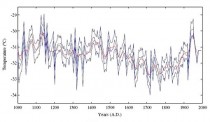World Climate Report
We hear over and over that any warming at the global scale will be amplified in the Arctic region of the Northern Hemisphere, and the warming will cause ice to melt and sea level to rise and all the rest. Let some ice-free area appear during summer near the North Pole and the global media will take the bait every time and announce we are witnessing geophysical changes of Biblical proportions. Several articles have appeared recently in leading journals with interesting results regarding the temperature history of the Arctic over the past 1,000 to 1,500 years, and they show that temperatures there have risen and fallen to a significant degree many times in the past (that is, without the benefit of large changes in atmospheric CO2 levels), and they call into question whether any unusual warming (or cooling) has occurred there in recent decades.
The first article appeared in Climatic Change and was generated by six scientists with California’s Scripps Institution of Oceanography, Japanís Institute for Global Environmental Strategies, the French Laboratoire de Glaciologie et Geophysique de l’Environnement, Japan’s National Institute of Polar Research, the University of California, San Diego, and Japan’s Meteorological Research Institute; the work was funded by the United States National Science Foundation.
This is a long and detailed article in which the authors show that temperatures in Greenland can be reconstructed using isotopes of nitrogen and argon trapped in air bubbles that can be found in ice cores. They used an ice core from central Greenland and made detailed measurements of the nitrogen and argon isotopes. Along with many other tests, Kobashi et al. compared their reconstructed temperatures to actual historical measurements from Greenlandís south and west coasts, and as seen in Figure 1, things look rather good.

Figure 1. Enlarged. Observed (blue) and reconstructed (red) Greenland temperature records. The observed record is a compilation of records from llulissat, Nuuk, and Qaqurtop located along the south and west coast of Greenland. To smooth the observed data, a 2-year moving average is applied (from Kobashi et al., 2010)
While the observational record is at best a few hundred years long, Kobashi et al.’s reconstructed temperatures go back 1,000 years (Figure 2). The full reconstruction is quite interesting as it clearly shows a relatively warm and early period culminating in greatest warmth near 1150; the Medieval Warm Period certainly appears in the record. A cooling begins near 1450 and culminates in a particularly cold period from 1700 to 1850; the authors refer specifically to the “severity of the late Little Ice Age”. Fortunately, Greenland recovered from the Little Ice Age with pronounced warming from 1850 to 1950. After the final period of cooling from 1950 through the mid-1990s that is depicted in Figure 2, temperatures have once again risen to mid-20th century levels (a rise that occurred after the end of the period of record analyzed by Kobashi et al. and thus not appearing on Figure 2). But before attributing the temperature rise during the past 10 years to the buildup of greenhouse gases, it is worth considering the ups and downs apparent in the entirety of the temperature record as shown in Figure 2, and also recalling that atmospheric CO2 levels were increasing between 1950 and 1995, when temperatures were declining in Greenland.

Figure 2. Enlarged. The last 1,000 years of Greenland temperature derived from nitrogen and argon isotopes in air bubbles in ice. Thick blue line is mean of results of Monte Carlo simulation, and thin blue lines are error bands (1σ![]() . Red line is a smoothed temperature history (50-year running mean) (from Kobashi et al., 2010)
. Red line is a smoothed temperature history (50-year running mean) (from Kobashi et al., 2010)
Peering back to 1000 AD was fun, but a second recent article in the Norwegian Journal of Geology contains an Arctic reconstruction going back even further, to 500 AD. The work was produced by three scientists with Norway’s University of Tromso and the Geological Survey of Norway. Rorvik et al. focused on a sediment core extracted from the Malangen fjord located in northern Norway. The fjord is well-situated to capture variations in temperature that would be reflected in changes in currents near the fjord. Just like magic, organic cysts collect on the bottom and over time, variations in the types of cysts are related to variations in temperature. The authors never produce a graphic showing the changes in temperature from 500 AD to present, but they clearly describe the results.
They note “In general, the time from c. AD 500 to 790 in the Malangen fjord is characterized as a cool period with reduced salinity. A cooling during this time interval, referred to as the Dark Ages Cold Period, is supported by regional and local history.” Next, they state “The dinocyst assemblages during the years AD 790 to 1500 indicate that the Medieval Warm period in the Malangen fjord, was characterized by increased inflow of warm, saline water. The Medieval optimum from the years AD 800/1000 to AD 1300/1500, has been reported as a warm phase from the VÝring Plateau, Norway, from North Sweden and northern Norway, Crete, Camp Century and GISP2 Greenland and Quelccaya Peru and from Nansen Fjord, eastern Greenland” (so much for the Medieval Warm Period being a local phenomenon - Peru is hardly near the Norwegian study area!).
Do you think they found evidence of the Little Ice Age (LIA)? Rprvik et al. state “Bottom water reconstructions in the Malangen fjord clearly reflect a cold period during the LIA and the dinocyst assemblages indicate that the time period from AD1500 to 1940 represents a cool period.” The Norwegian reconstruction shows warming since 1940 (in their zone D in the core); the authors write “The interpretation of the dinocyst assemblages of zone D, is consistent with somewhat less influence from waters outside the basin and is interpreted to represent a period with relatively high surface temperatures.”
There is no evidence presented comparing the current warm period to the Medieval Warm Period. But a message is clear - temperatures in the high latitudes are naturally quite variable, even on timescales of hundreds of years.
We’ll keep our eyes on the situation, but based on these articles, you’d be hard-pressed to conclude that temperatures in these regions as of late have risen above the rather high noise level characterizing natural variation.
References
Kobashi, T., J.P. Severinghaus, J.-M. Barnola, K. Kawamura, T. Carter, and T. Nakaegawa. 2010. Persistent multi-decadal Greenland temperature fluctuation through the last millennium. Climatic Change, 100, 733Ė756.
Rorvik, K.-L., K. Grosfjeld, and M. Hald. 2009. A late Holocene climate history from Malangen, a north Norwegian Fjord, based on dinocysts. Norwegian Journal of Geology, 89, 135-147.
By Jason Samenow, Capitol Weather Gang, Washington Post
Less than three weeks after resigning as AccuWeather’s chief long-range forecaster, Joe Bastardi announced Friday that he has accepted the position of chief forecaster at WeatherBell, a fledgling weather consulting firm.
WeatherBell has also hired veteran meteorologist Joseph D’Aleo, who served as the Weather Channel’s first director of meteorology.
Based in New York City, WeatherBell Analytics LLC will offer meteorological products and services geared toward helping businesses manage weather risk. The company is funded entirely by angel investors. Chief executive officer Michael Barak said the name of company was inspired by someone close to him.
The company will target the financial, agriculture, and energy sectors, said Barak. It intends to leverage the forecasting talents of Bastardi and D’Aleo to help businesses in these sectors make the best decisions, he said.
“We will provide the most accurate forecasts anywhere, and because of this our clients will be able to adjust their business strategy and maximize profits,” said Barak.
WeatherBell has partnered with Skyline Software Systems, Inc., a 3D geospatial visualization software and services company based in Chantilly, Va. Skyline’s suite of web-based software will allow WeatherBell customers to fuse their own data with weather data and forecasts.
Barak, 27, previously worked as a vice president at an aerospace engineering firm. Although he has had a passion for weather since childhood, he is not a meteorologist and stressed that Bastardi will be given complete independence in developing his forecasts.
“Joe will have unlimited freedom at WeatherBell, and you can expect to see that enthusiastic bold forecaster many of us have followed for years,” he said.
Bastardi says he is relishing the opportunity to help build a new forecasting enterprise.
“WeatherBell will give me the chance to display my ability and my good name in the way I am most suited,” he said. “I look forward to building from the ground up an operation that will become the standard in private sector forecasting.”
Bastardi said it was a “difficult decision” to leave AccuWeather after 33 years without providing reasons for his departure. “I wish my former employer well just as they have wished me well, but I would like to keep my reasons for leaving private,” he said. While at AccuWeather, Bastardi developed a large following on AccuWeather’s subscription-based “Pro site” featuring blog commentary and video discussions.
Barak said WeatherBell will also have a subscription-based site where Bastardi will provide forecast commentaries and video. Bastardi’s first blog posts for WeatherBell are now available. D’Aleo has also published his initial blog post on the WeatherBell website.
During his tenure at AccuWeather, Bastardi was also a frequent guest on Fox News where he discussed not only weather but his skeptical position on global warming. Barak said Bastardi as well as D’Aleo would be free to do television appearances and speak their mind but emphasized WeatherBell is “not a media company.”
Barak is well aware of Bastardi’s controversial position on global warming not to mention D’Aleo’s, who independently runs the skeptic website Icecap.us. Barak said his company does not have a position on the issue and will not interfere with either Bastardi’s or D’Aleo’s opinions.
See post.
Freedom Action
Freedom Action Supports Quick Passage
Washington, D.C., March 10, 2011 - A House subcommittee on Thursday is expected to mark up a bill, the Energy Tax Prevention Act, sponsored by Energy and Commerce Committee Chairman Fred Upton (R-Mich.) and Subcommittee Chairman Ed Whitfield (R-Ky.) that would block the Environmental Protection Agency from regulating greenhouse gas emissions using the Clean Air Act. Freedom Action supports enactment of their critical legislation.
“The Energy Tax Prevention Act is one of the most important bills that Congress will vote on this year. We applaud Chairmen Upton and Whitfield for their efforts to move it quickly to the House floor. The future economic prosperity of America is at stake,” said Myron Ebell, Director of Freedom Action.
Under the Obama administration, EPA has been moving forward with new Clean Air Act regulations to reduce greenhouse gas emissions. The new regulations will do nothing to reduce global levels of the gases alleged to cause global warming, but will raise energy prices, make consumers poorer, and destroy jobs in manufacturing and other energy-intensive industries.
“The Obama Administration’s EPA is trying to implement cap-and-trade, which was defeated in Congress and overwhelmingly rejected by the American people, through the regulatory back door. And as President Obama promised during the 2008 campaign, under his plan ‘electricity rates would necessarily skyrocket,’” Ebell concluded.
“The debate on EPA’s greenhouse gas regulations boils down to a very simple issue. Who shall determine the content and direction of national policy - elected representatives accountable to the people at the ballot box, or non-elected bureaucrats, trial lawyers, and activist judges appointed for life? The Constitution permits only one answer to that question,” said Marlo Lewis, Senior Fellow at the Competitive Enterprise Institute, an affiliate organization to Freedom Action.


